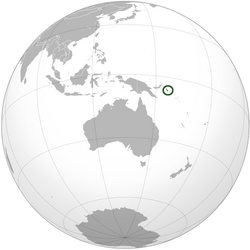The Republic of the North Solomons was an unrecognised state that purported to exist for about six months in what is now the Autonomous Region of Bougainville, Papua New Guinea (PNG). It involved:[3][4]
a 'Unilateral Declaration of Independence of the Republic of North Solomons' and a failed bid for self-determination at the UN
| This article needs additional citations for verification. (October 2013) |
Quick Facts Status, Capital ...
Republic of the North Solomons |
|---|
|
|
|
 |
| Status | Unrecognized state |
|---|
| Capital | Arawa[1] |
|---|
| Government | Republic |
|---|
| President | |
|---|
|
• 1975–1976 | Alexis Sarei |
|---|
|
|
| Chairman | |
|---|
|
• 1975–1976 | John Momis |
|---|
|
|
| History | |
|---|
|
• Declared | 1 September 1975 |
|---|
• Reintegrated into Papua New Guinea as "North Solomons Province" | 9 August 1976[2] |
|---|
• Disestablished | 1976 |
|---|
|
|
|
|
Close
Independence was unilaterally declared on 1 September 1975,[2] from the Australian-administered territory of Papua and New Guinea, which itself was due to become independent on 16 September.
In October 1975, the town council of Kieta voted unanimously to disband and hand over its assets to the North Solomons government.[5]
Tensions soon escalated and by mid-1976, the Papua New Guinea riot police squad was sent to southern Bougainville to restore order.[3] John Momis, at the time Chairman of the putative Republic's ruling council, denounced this action as an invasion.[3]
Mutual concerns about security on the island and the Republic's failure to achieve any international recognition eventually led to talks between the PNG Government and the secessionist leader.[3] A settlement was reached in August 1976 on the basis of increased decentralisation. Bougainville was renamed "North Solomons Province", in recognition of its geography, and re-absorbed politically into PNG with increased self-governance powers, a model later replicated to delineate provincial powers throughout PNG.[3]
The chairmanship of the North Solomons interim government was initially offered to Bougainville district commissioner Alexis Sarei, who declined on the grounds that he could not commit to the role full-time due to family matters.[6] In October 1975, John Momis was announced as the interim chairman of the government, responsible for govermnent policy, with Sarei as chief secretary holding responsibility for administrative matters. The other members of the executive were Hanao Tato, Clement Dana, Asurei Tolovai, John Dakeni, Raphael Bele, Aloysius Noga, and Anthony Anugu. A number of public servants were engaged as assistants to Sarei, including Moses Havini, Thomas Anis, Simon Tania, Joseph Noro, James Dogel, and John Dove.[7] Leo Hannett was appointed as government spokesman and plans were announced for an election to be held by the end of 1975.[8]
In December 1975, the interim government announced its plans to abolish all local government councils and replace them with village governments, which would collect a head tax and be responsible for rural development. It was reported that the breakaway government had been evicted from Arawa House and relocated to the Catholic mission at Tunuru, where they had established offices in a converted maternity ward.[9] The government also resolved that all Bougainville businesses should pay their 1975–76 income tax to the North Solomons government.[10]
The Bougainville independence referendum: Assessing the risks and challenges before, during and after the referendum by Jo Woodbury
January 2015; Commonwealth of Australia
Other People's Wars: A History of Australian Peacekeeping; Peter Londey;
Allen & Unwin, 2004; Laracy 'Bougainville secessionism'

